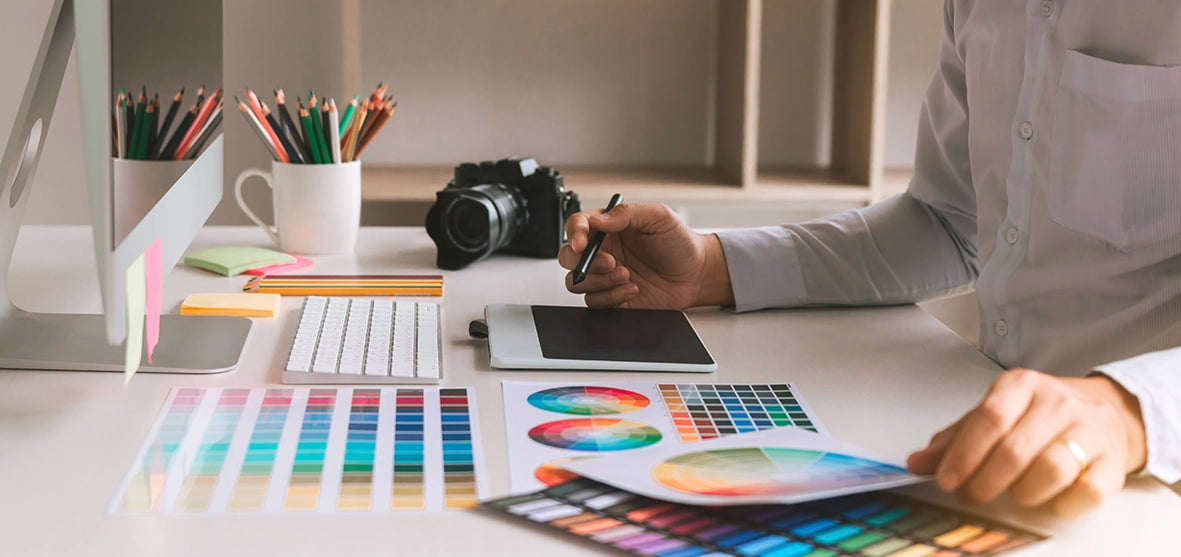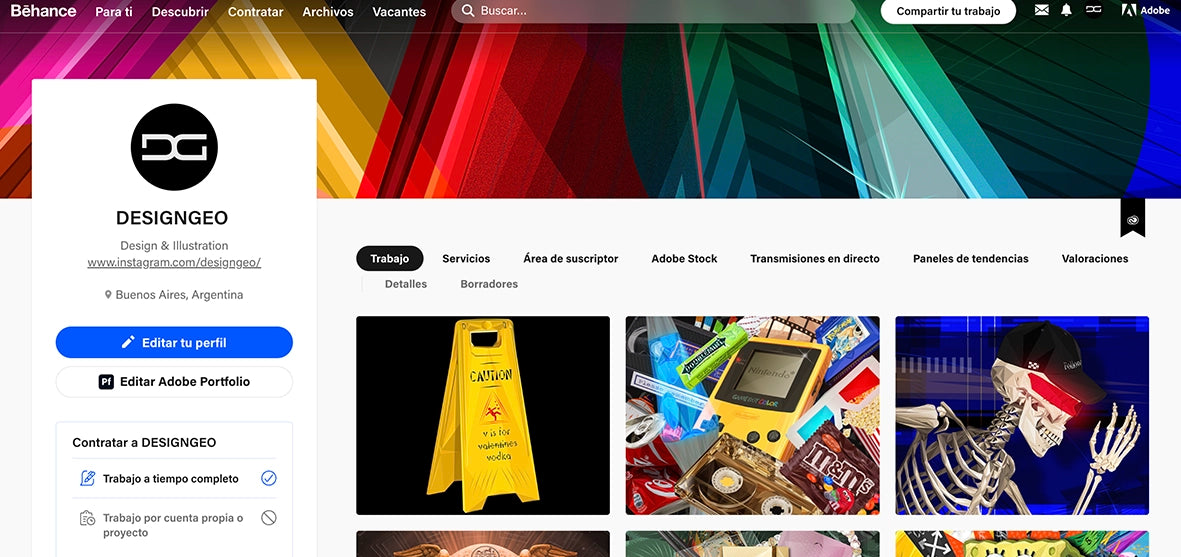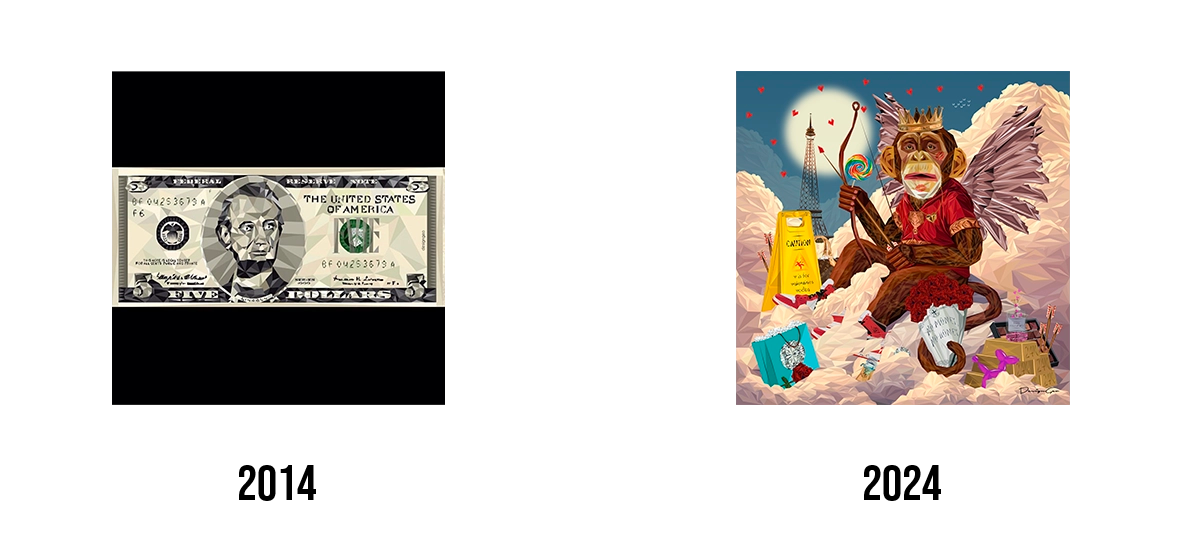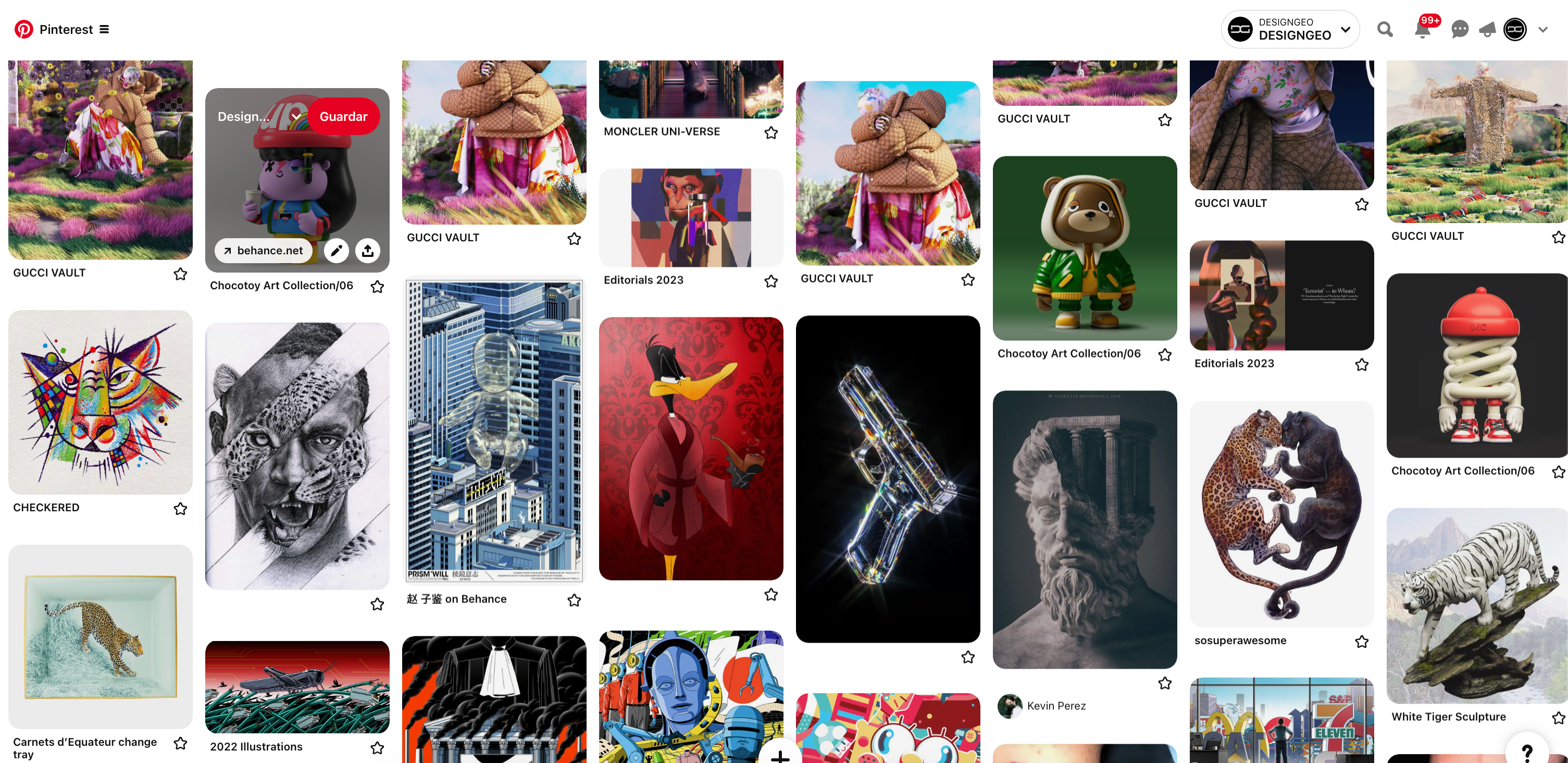The 9 Keys That Made me Create a Successful Career as a Digital Illustrator
In this publication, I want to tell you a little about the 9 key points that allowed me to create a career as an independent digital illustrator and make a living from what I love. Keep in mind that these nine points are what worked for me, and I applied and learned them over my more than ten years as a creative. Without further ado, let's start looking at each of them in detail!
- Know what you want
- Your habits define you
- Continuous learning
- Create a portfolio and share your work with the world
- Learn to listen
- Practice, practice, and more practice
- Stay updated
- Improve in all personal and professional aspects
- Develop patience
1. Know What You Want
First things first. Before I start telling you the 9 keys that allowed me to get where I am today and live as a digital illustrator for over 10 years, you need to understand the following: The fundamental first step to start your career as a digital illustrator is to feel and internally desire that this is what you really want. It may sound obvious, but that is the foundational basis upon which you will build the pillars of your professional career as a creative. You must visualize yourself developing this beautiful profession over the years. The feeling and internal desire to want to start in the world of digital art will make everything much easier even when challenges that seem difficult to overcome arise.
Once you know it and have it clear, you will probably ask yourself the following question: How to be a successful digital illustrator? The reality is that we are not talking about an exact science or magical formulas that we can follow to develop our career. What is important to say is that each creative develops and creates their own path, whether individually or as a team, and that is why you must start walking your own.
Defining your graphic style and the main theme you want to develop is key. These two points are undoubtedly vital to start creating a corporate or personal brand identity that over time will make it easier for people to identify your work regardless of whether it is signed or not, or if your logo appears somewhere.
To give you a personal example, I chose the theme of luxury lifestyle and popular consumption, and on the other hand, the geometric low-poly style to develop my creations.
A practical tool is the creation of mood boards or folders with different visual references that can help you move forward with a clear direction and start creating your creative universe around this. Remember that none of this is definitive, and if you decide to change your graphic style or the theme of your illustrations, you can do it; they are simply points that it is important for you to consider as a checklist to be able to improve in the things that you really like because it will make everything much easier.
2. Your Habits Define You
Habits are another key factor that determines our future. Think of it this way: everything we do today will be small contributions so that tomorrow we can live the reality we dream of.
The use of notes and agendas has helped me when structuring my time and the activities to be developed, so it is something that I recommend because it helps to be more productive. On the other hand, getting all the ideas and thoughts out of your head and putting them on paper will help you feel lighter and think more clearly.

Returning to the title of this point "Your habits define you," I must make the following recommendation: dividing your big goals into small objectives will allow you to progress more, even when you feel that what you are doing does not generate progress on a day-to-day basis. Many times, I set goals and objectives as big as, for example, sharing 3 illustration projects per month, and the way to achieve it was to divide the number of illustrations to be made over the 30 days to be able to comfortably and organizedly reach the goal. That's why breaking it down into small parts will help you achieve a key balance, and you will be able to progress more easily.
3. Continuous Learning
You must be a lifelong learner. There comes a time when one realizes and understands that one never stops learning. In our profession, new techniques, technological advances, and the variety of elements that constantly change force us to have to be in lifelong learning mode.
Although studying a career is not necessary and crucial to living as a digital illustrator, it may be what gives you the main tools and contacts necessary to grow professionally. In my case, I studied graphic design, and although much of the theory learned over the years served me and I apply it on a daily basis, the vast majority of achievements and opportunities reached have little to do with my studies, but rather with my desire to grow, improve, and perfect my particular style.
The range of careers and institutions is unlimited, as is the number of free courses and tutorials available on the internet. Always try to follow your intuition and do what you like the most because this will allow you to stay on a path of progress.
Studying compulsorily at a university makes no sense whatsoever, so if in practice you get along better studying and learning self-taught by watching tutorials from home, that's the way to go. In the end, you are the one who knows which of all the options is the best to generate greater progress over time.
4. Create a Portfolio and Share Your Work With The World
The personal portfolio of a digital illustrator or creative is their letter of introduction to the world. It is super important to make a selection of the best works to show your unique style and your graphic skills in the best way possible.
After curating your best works, it is important to keep it updated as you develop new projects and works. The use of pages to create portfolios for creatives like Behance can be very useful so you don't waste time creating your own website.
In my case, I created my portfolio on Behance in 2013, and it wasn't until 2020 that I really started doing what I had to do. Taking the time to select my best works, show the behind-the-scenes of the creative process, and write a brief description for everything to take on greater consistency. In recent years, having shown the detail of my work, telling a little more about the ideas and the time it takes me to create each thing, and showing my digital illustrations in the best possible way ended up opening many doors for me at a work level, as well as allowing me to meet other creatives, which is very interesting.
In the end, if you don't know how to sell yourself as a professional and don't adequately show your work, it will take longer than desired for opportunities to arrive and may end up discouraging you. That's why I encourage you to create your portfolio on your preferred platform, look for references from other creatives, take the time to prepare the text and images to show everything in the best way, and end up showing and sharing all your creativity and skills with the world.
5. Learn To Listen
In the vast world of digital illustration, where creativity merges with technology, there is a skill that is often overlooked but fundamental: learning to listen. Beyond mastering digital tools or perfecting technique, the ability to listen is what truly distinguishes a great digital illustrator.
What does learning to listen really imply in this context? It is about being attentive to more than just what is said verbally. It is about capturing the emotions, nuances, and needs behind the words. When working with clients or collaborators, this means fully understanding their vision, expectations, and communication style.
When a client describes their idea for a digital illustration, it is crucial not only to understand the specific details, such as colors or composition but also to capture the essence of what they are trying to convey. What emotions do they want to evoke? What message do they want to communicate? Only by listening carefully and asking the right questions can we discover these answers and transform them into meaningful digital art.

The ability to listen also extends beyond interactions with clients. In a teamwork setting, digital illustrators must be able to listen to the ideas and suggestions of their colleagues. This not only fosters a collaborative environment but can also lead to the generation of more creative ideas and innovative solutions.
Furthermore, learning to listen to oneself is equally important. Moments of introspection and reflection are crucial for the personal and professional growth of a digital illustrator. Listening to our own inner voice allows us to identify areas for improvement, explore new artistic directions, and stay connected to our passion for digital illustration.
6. Practice, Practice, and More Practice
Practice makes perfect, and there's no other way around it. The best way to refine your technique and skills is by practicing. Personally, I have been working with Adobe Illustrator for over 10 years, and I can assure you that my creations from 2010 bear no resemblance to the complex illustrations I can create today in 2024. (You can see all the progress here).
In the same way that I tell you about my graphic skills with design software, I can tell you how I improved my process for searching and reaching new ideas or how I optimized my schedule to be more productive throughout the day, especially when I had to work on projects for both myself and clients. The only way to improve and perfect everything is by practicing, and I want you to take that with you.
As in all things we do related to design or not, practice (combined with continuous study) is the only thing that will allow you to scale and grow personally and professionally.
7. Stay Updated
Staying updated will allow you to be at the crest of the wave. Continuous visits to websites and blogs related to graphic design and digital illustration will help you stay alert to changes within the market, technical advances, and current trends. All this information that is so practical and up-to-date allows us to take ideas to generate new ones.
In addition to visiting design blogs, you can look for ideas and trends on Pinterest or Behance. Personally, I look a lot at the featured collections on Behance to see references and works of other established digital illustrators within the creative industry. I also usually create different boards with ideas and references on Pinterest that help me facilitate the start of different projects.
8. Improve In All Personal and Professional Aspects
In the world of digital illustration, personal and professional growth is a constant journey. To thrive in this discipline, it is essential to cultivate an approach that encompasses all aspects of our being. Developing and improving in all areas, both personal and professional, not only boosts our creativity but also strengthens our ability to face market challenges and connect with our audience more effectively.
First, personal development is essential. This involves cultivating an open, curious, and receptive mindset. By being willing to explore new ideas, techniques, and styles, we expand our creative horizon and stay in constant evolution. Additionally, working on our emotional and physical well-being provides us with the energy and mental clarity necessary to tackle projects with enthusiasm and determination.
In parallel with personal growth, it is crucial to invest in professional development. This includes refining our technical skills in digital illustration software, exploring new tools, and learning from emerging trends in the field. Likewise, developing time and project management skills helps us be more efficient and organized, thus optimizing our performance and our ability to meet deadlines.
9. Develop Patience
Patience will take you far. Understanding that nothing happens overnight and that things do not happen when we want them to. We live being impacted by visual stimuli from television, social networks, etc. That is why it is important that you focus on yourself and do not look at and compare yourself to the people around you. I understand that it is a constant competition with myself and not with the rest, and it depends on me to stay focused to progress and achieve what I want in life.
I am aware that there are days when it becomes very difficult and things seem to go uphill, but refocusing and being able to go to sleep every day with the peace of mind of having made progress, no matter how minimal, towards reaching our goals will help us progress day by day.
I have many personal examples to share, but to give you some ideas, I'll share two: The first example is that since I started my career as a creative, I wanted to collaborate with some internationally renowned brand. This happened only 2 years later when I had the opportunity to create some posters for the brand MCT watches that were presented at Baselworld 2016.

Another example is a goal that arose in 2020, which was to improve my Behance portfolio and achieve greater visibility from my first featured project. Although it is not something linear that one can do and achieve, I focused on sharing quality projects where I show everything to add value to those who visualize the project. My first featured project came 3 years after I started preparing quality projects to share.
The conclusion is that if I had given up earlier and had not had the patience and perseverance to continue day by day, even though things didn't happen when I wanted them to, the fact of staying focused allowed me to achieve and fulfill some of the objectives I had throughout the years.

I hope these nine points help you as a starting point to start or steer your career as a digital illustrator. Remember that everyone makes their own path, and that is what is exciting about the creative world. At the end of the day, everything depends on you and your love for this wonderful profession. If any of these points help you or if you want to ask me any questions or make comments, do not hesitate to do so through my social media profiles!








Leave a comment
This site is protected by hCaptcha and the hCaptcha Privacy Policy and Terms of Service apply.